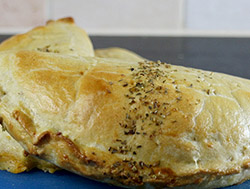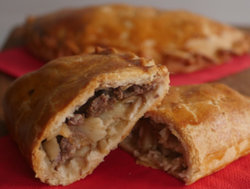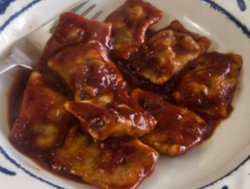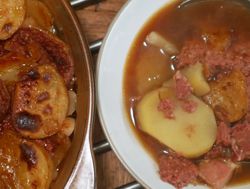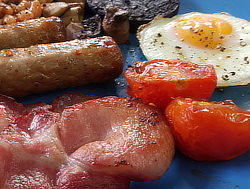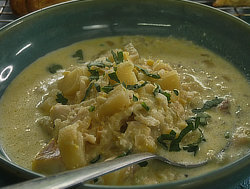
Pierogi Ruskie
Introduction & method
Pierogi are associated with Poland, but they are quite common in East Europe and Slavic countries, and of course, wherever Poles have settled. Pierogi (that's the plural) are very similar to the Italian ravioli but they're generally not served with a sauce. You can eat them hot or cold, as a snack, a side dish or part of a main meal. They take a bit of practice to make, but it is worth the effort.

Make the Dough
In a large bowl, mix together the salt and the flour. In a smaller bowl, beat the eggs into the water. Add the eggy water to the salty flour and mix well. If the mixture seems too dry, and a bit more water. When the dough comes together and leaves the inside of the bowl clean, tip it out onto a floured worktop. Knead the dough for a minute or two until it's smooth - it'll be very sticky and you might want to use a pastry scraper to start with. Put the dough back in the bowl, cover it with a damp tea towel and leave it in the fridge to rest for at least 30 minutes.
Make the Ruskie Potato and Cheese Filling
Peel the potatoes and chop them into equal-sized chunks, a bit smaller than bite-sized. Pop them in a large pan of boiling water and cook until tender, about 10-15 minutes. Peel and finely slice the onion. Sauté in oil and butter for 10-15 minutes until well-browned. Drain the potatoes, add a teaspoon of salt and mash the spuds with the cottage cheese. Stir in most of the onion at the end, but reserve a bit for garnish.
Make the Mince Pork Filling
Peel and finely chop the onion. Heat some oil in a frying pan and sauté for about 5 minutes - we want to soften them, not brown them. Mince the garlic and cook with the onion for about a minute, then add the minced pork. Break it up and stir it to get it browned all over. Add water and tomato purée, stir them in well, then add parsley and thyme. Let it cook for about 10 minutes, taste it, and add salt and pepper to taste. Remove from heat and allow to cool. While it's cooling use a stick or immersion blender to turn the filling into a smooth paste.
Assemble the Pierogi
Sprinkle a generous amount of flour on your worktop, take half of the dough and roll it out to 2-3mm thick (about an eighth of an inch). Use a 50mm (2 inch) diameter cutter to stamp out as many discs as you can. If you don't have a cutter, find a glass or a jar top that's the right size. TIP: don't stack the dough - it's very sticky and no matter how much flour you use to separate the discs, they'll find a way to stick together and ruin your life. Spoon a dollop of filling on each disc. Exactly how much is a matter of practice. Pick up a disc and stretch the dough over the filling until it meets the other edge of the disc. Press the two edges together to make them stick, being very careful not to get any filling trapped in the joint. Lay the half-moon parcel down and press the top gently to push the filling towards the fold - smooth out the fold a bit to get it perfectly straight. Press around the edge of the pierog with the tines of a fork to strengthen the seal and form a bit of a crimping pattern. When you've used up the first batch of dought, repeat the exercise with the remainder.
Many pierogi recipes tell you to not re-roll the trimmings left after cutting out the discs. Instead, cut them or shred them, let them dry a bit a use them in soups. But actually, I re-rolled mine and made a few extra pierogi, nae problemmo.
Cook the Pierogi
Bring a large pan of water to a rolling boil. Cook the pierogi in batches of 6-8 - you don't want to overcrowd the pan. Add the pierogi to the water. Once they're all in, stir gently to make sure they're not sticking to each other or the pan. They'll float to the top after a minute or two, but you need to cook them for 3 minutes. Remove with a perforated spoon and place on kitchen paper to dry. Cook the next batch.
You can eat them at this point, or freeze them, but I think they look and taste far better if you fry them a little bit. To do this, melt some oil and butter in a frying pan on medium-low heat. Add some pierogi and let them gently bubble away. When they're a light golden-brown on one side, turn them over and do the other side. You'll need to experiment a bit to get the temperature right so they don't brown too fast or too slowly.
Serve the Pierogi
Arrange the pierogi around a small bowl of soured cream. Sprinkle with fried onion, fresh dill and parsley.
Ingredients & Info
DOUGH
 500 grams plain (all-purpose) flour
500 grams plain (all-purpose) flour 150 ml water
150 ml water 2 eggs
2 eggs 1 tsp salt
1 tsp saltRUSKIE FILLING
 4 medium potatoess
4 medium potatoess 150 grams cottage (farmers) cheese
150 grams cottage (farmers) cheese 1 medium onion
1 medium onion 1 tsp salt
1 tsp saltMEAT FILLING
 250 grams minced pork
250 grams minced pork 1 medium onion
1 medium onion 2 tbsp tomato puree
2 tbsp tomato puree 2 tbsp water
2 tbsp water 1 tsp dried parsley
1 tsp dried parsley 1 tsp dried thyme
1 tsp dried thyme salt and pepper to taste
salt and pepper to tastePLUS
Oil and butter for sautéeing. Soured cream, fresh dill and parsley to garnish.
Prep time: 20 minutes.
Resting time: 30 minutes.
Cooking time: 20 minutes.
Total time: 1 hour 10 minutes.
